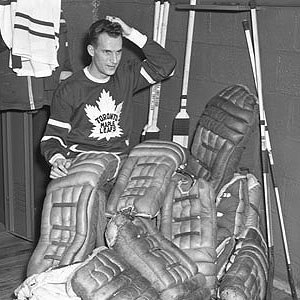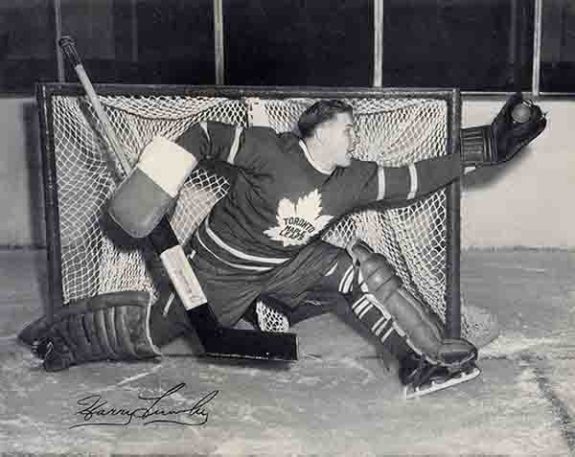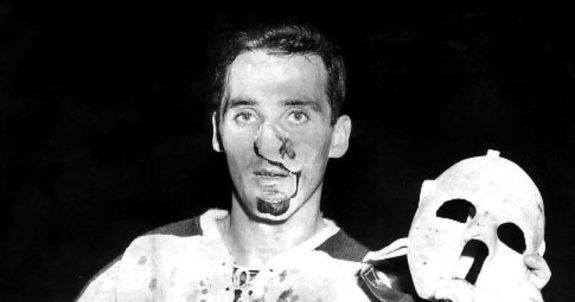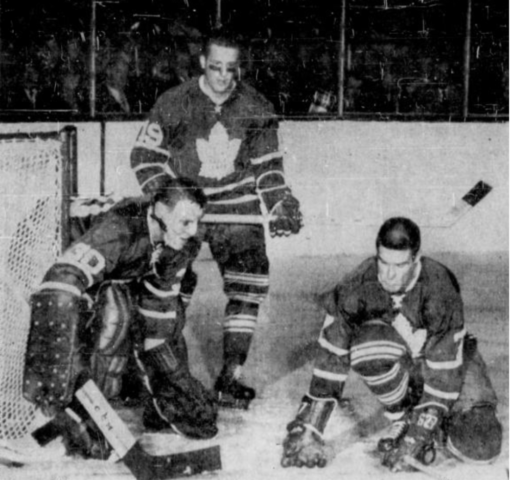The 1950s was a decade of evolution and innovation across the National Hockey League. The goaltender position was played much differently than what we see today. Masks were not worn for much of the decade, if at all, and the backup was yet to become a mainstay in the game. These are the best five netminders to have played in the decade, many of which changed the game forever.
#5 Glenn Hall
You don’t earn the nickname “Mr. Goalie” without being a legend at the position. While the majority of Glenn Hall’s success came in the 1960s, with a Stanley Cup, a Conn Smythe Trophy and three Vezina Trophies, he planted the seeds of his Hall of Fame career in the 1950s.
After playing in eight games over two seasons for the Detroit Red Wings, he became their full-time netminder and played in all 70 games of the 1955-56 season. In fact, when he took the ice on Oct. 10, 1955, against the Chicago Black Hawks, he began a record-setting streak of consecutive games played. He would be between the pipes for every game until Nov. 7, 1962, and his record of 502 consecutive games played will never be broken. He never wore a mask for any of those 502 games.
His rookie season was one for the ages as he finished with 30 wins, a 2.10 goals-against average (GAA), .925 save percentage (SV%) and 12 shutouts. He won the Calder Trophy for being the league’s top rookie performer and guided the Red Wings to the Stanley Cup Final.
He finished the 1956-57 season with a career-high 38 wins and played in his first of 13 NHL All-Star Games. In the summer of 1957, he was traded to the Black Hawks, along with Ted Lindsay, for four players. He would spend the next decade in Chicago before being drafted by the St. Louis Blues in the 1967 expansion draft.
Related – The Best of “Mr. Goalie” Glenn Hall
He played in every single game for the Black Hawks from the start of the 1957-58 season until the end of the decade. Even though he led the league in losses during his first season with the Black Hawks, he still played in the All-Star Game.
#4 – Al Rollins
Al Rollins’ record may not be as good as his contemporaries, but when you are playing in a league with the six greatest goaltenders in the world, somebody has to lose.
He broke into the NHL during the 1949-50 season with the Toronto Maple Leafs to back up an aging legend in Turk Broda. He went 26-6-7 with a 1.77 GAA splitting time during the 1950-51 season. He went 3-1 with a 1.72 GAA in four playoff games, helping Toronto to a Stanley Cup victory. He won the only Vezina Trophy of his career for his efforts that season.

Despite good numbers the following season, he could not convince the Maple Leafs to be their full-time netminder. In September of 1952, he was traded to the Black Hawks, with three other players, for another goaltender who appears later on this list.
His first season in Chicago was his best with 29 wins and a 2.19 GAA and it would be the last time he’d play in the Stanley Cup playoffs. There was not a lot of team success over the next four seasons, but Rollins was still viewed as one of the best goaltenders in the game.
During the 1953-54 season, he played in the All-Star game and won the Hart Trophy despite a 12-47-7 record. He is one of only two eligible players who have won the Hart Trophy not to be elected to the Hockey Hall of Fame.
Once the Black Hawks acquired Hall, Rollins spent the next two seasons playing in the minor leagues. He signed with the New York Rangers at the start of the 1959-60 season and appeared in 10 games for them before calling it a career.
#3 – Harry Lumley
Harry Lumley spent the 1950s playing for four of the Original Six teams, but his success was consistent no matter what city he called home.
Lumley first made a name for himself during the 1943-44 season when he became the youngest goaltender to ever start in an NHL game; a record he still holds to this day. He allowed 13 goals in two starts with the Red Wings as a 17-year-old.

He began the 1950s by winning the only Stanley Cup of his career with the Red Wings. During the 1950 Stanley Cup playoffs, Lumley went 8-6 with a 1.85 GAA and three shutouts. He was traded to the Black Hawks shortly after the Cup win as part of a nine-player swap as the Red Wings had the man who tops this list ready to take over the goaltending duties in Detroit.
His first stint in Chicago was not great by any means. He went 29-85-19 in two seasons with a 3.64 GAA. He was traded to the Maple Leafs just prior to the start of the 1952-53 season for four players including Rollins.
His second season in Toronto was the best of this career. He went 32-24-13 with a 1.86 GAA and 13 shutouts during the 1953-54 season. Those 13 shutouts were an NHL record for the most in a single season until Tony Esposito posted 15 in 1969-70. Lumley won his only Vezina Trophy that season and was an All-Star for the first of three times.
In 1956, Lumley was traded back to the Black Hawks but he refused to play with them. He spent the 1956-57 season with the Buffalo Bison and Providence Bruins in the American Hockey League. In January of 1958, he was traded to the Boston Bruins where he spent the final three seasons of his career.
Lumley also helped to innovate an advantage for future goaltenders. He was the first netminder to put a pocket in his pads, at shin level, so pucks would drop straight down instead of bouncing back into the middle of the ice.
#2 – Jacques Plante
While his career lasted well into the 1970s, Jacques Plante had a great amount of success during the 1950s with the Canadiens. He is not just remembered for being one of the most successful goaltenders to ever play, but also one of the most innovative ones as well.
Plante got his name engraved on the Stanley Cup for the first time in 1953. After appearing in three regular-season games, he played in the first round of the playoffs against the Black Hawks, subbing for an injured Gerry McNeil. He won three out of the four games he started, giving up a total of seven goals and earning one shutout.
In February of 1954, Plante became the starter in Montreal and did not relinquish that position until 1963 when he was traded to the Rangers. He was a big part of a historic run that saw the Canadiens win five straight Stanley Cups between 1956 and 1960.
During the 1950s, Plante played in 65 postseason games, posted a 1.99 GGA, a .923 SV% had seven shutouts and won five of his six career Stanley Cups. Five of his seven career Vezina Trophies came during the decade, as well.
Plante’s story only begins with his Hall of Fame-worthy numbers. He also left a mark on the game that is still felt to this day. He was one of the first goaltenders to leave the crease and play the puck behind the net. He also used his stickhandling as a weapon and perfected the art passing to his teammates, something that was yet to be seen from netminders.
Related – Jacques Plante: The Man Behind the Fiberglass Mask
During his career, Plante became a master of the stand-up style of goaltending, which helped him cut down on the angle opponents could shoot at him. He was one of the first professional goaltenders to ever write a book on how to play the position.
On Nov. 1, 1959, Plante had his nose broken early in a game against the Rangers. When he returned to the ice after repairs, he was wearing the same homemade mask he had been sporting in practice for the last few years.

Head coach Toe Blake was not happy with the mask, but Plante refused to play without. He would wear the mask during an 18-game unbeaten streak and took it off once it was over. He lost the first game without the mask, so it returned the following game and remained for the rest of his career.
#1 – Terry Sawchuk
Terry Sawchuk isn’t just considered the greatest goaltender of the 1950s, but he is on the Mount Rushmore of the all-time greats. At the time of his tragic death in 1970, Sawchuk was the greatest goaltender to ever play in the NHL. His 477 regular-season win remained the high-water mark for thirty years and his record of 103 career shutouts stood until 2009.

Sawchuk took over goaltending duties for the reigning Stanly Cup champion Red Wings at the start of the 1950-51 season. He played in all 70 games, winning 44 of them, with a 1.97 GAA and 11 shutouts on his way to the Calder Trophy as the league’s top rookie.
The following season, he repeated his 44 wins in 70 games and won the first of his three Stanley Cups and Vezina Trophies with the Red Wings. During the 1952 playoffs, Sawchuck went 8-0 with four shutouts, giving up just five total goals, in sweeps of the Toronto Maple Leafs and Montreal Canadiens.
He won the Vezina again in 1953 and 1955 while leading the Red Wings to back-to-back championships in 1954 and 1955. He played in the NHL All-Star Game in every year of the decade except for 1957 and 1958.
The Red Wings traded Sawchuck to the Bruins in 1955 because they had a young Hall waiting in the wings to take over. A case of mononucleosis during his second season in Boston led him to retire in early 1957. However, he returned to the ice the next season and was reacquired by the Red Wings for future Hall of Famer Johnny Buyck.
Related – The 5 Greatest Goaltenders in NHL History
While Sawchuk is most remembered for his wins and shutouts, he was one of the toughest players to ever lace up a pair of skates. During his career, he had three elbow surgeries, an appendectomy, endless cuts and bruises, a broken foot, a collapsed lung, ruptured discs and severed tendons in his hand.
He received well over 400 stitches in his face before finally wearing a mask in 1962. This was back in the era when there was no such thing as a backup goaltender, so Sawchuk played through the pain. His name is still mentioned today when discussing the greatest goaltenders to ever play the game.
Enjoy more great hockey history and ‘Best of’ posts in the THW Archives